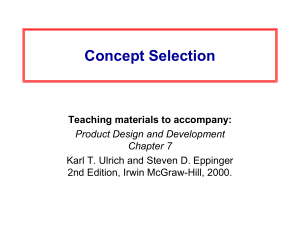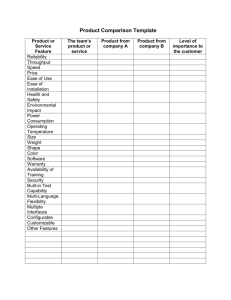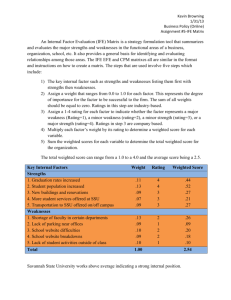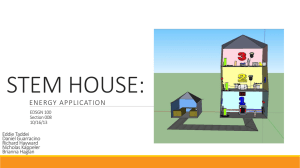Concept Selection
advertisement
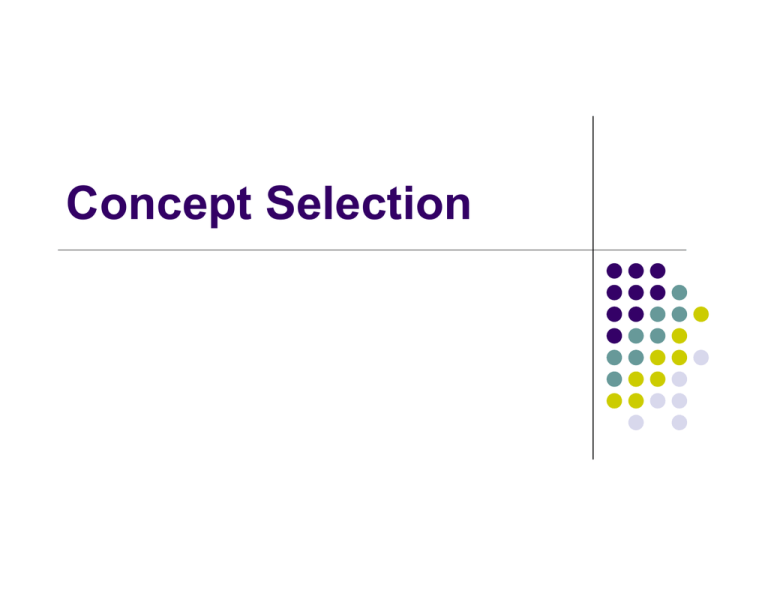
Concept Selection Product Development Process Planning Planning Concept Concept Development Development Mission Approval System-Level System-Level Design Design Concept Review Detail Detail Design Design System Spec Review Testing Testingand and Refinement Refinement Critical Design Review Production Production Ramp-Up Ramp-Up Production Approval Concept Development Process Mission Statement Identify Customer Needs Establish Target Specifications Generate Product Concepts Select Product Concept(s) Test Product Concept(s) Perform Economic Analysis Benchmark Competitive Products Build and Test Models and Prototypes Set Final Specifications Plan Downstream Development Development Plan Concept Development Funnel concept generation concept screening concept scoring concept testing Concept Selection Process z z z z z z Prepare the Matrix z Criteria z Reference Concept z Weightings Rate Concepts z Scale (+ – 0) or (1–5) z Compare to Reference Concept or Values Rank Concepts z Sum Weighted Scores Combine and Improve z Remove Bad Features z Combine Good Qualities Select Best Concept z May Be More than One z Beware of Average Concepts Reflect on the Process z Continuous Improvement Selection Process Outcomes z Team Consensus on Superior Concept z z z Conditional Consensus z z z z “Green Light” Everyone “On Board” More Information on some Criteria Market or Technical Feedback Consensus on Disagreement No Consensus z z Criteria not Understood Back to Needs Example: Concept Screening CONCEPT VARIANTS SELECTION CRITERIA Ease of Handling Ease of Use Number Readability Dose Metering Load Handling Manufacturing Ease Portability PLUSES SAMES MINUSES NET RANK CONTINUE? A B C D E F G REF. 0 0 0 + 0 + + 3 4 0 3 1 Yes 0 – 0 + 0 – + 2 3 2 0 3 Yes – – + + 0 – – 2 1 4 –2 7 No 0 0 0 + 0 0 – 1 5 1 0 5 No 0 0 + + 0 0 0 2 5 0 2 2 Yes – + 0 0 + – – 2 2 3 –1 6 No – 0 + + 0 0 – 2 3 2 0 4 Yes 0 0 0 0 0 0 0 Example: Concept Scoring Concepts A (reference) Master Cylinder DF E G+ Lever Stop Swash Ring Dial Screw+ Weight Rating Weighted Score Rating Weighted Score Rating Weighted Score Rating Weighted Score 5% 3 0.15 3 0.15 4 0.2 4 0.2 Ease of Use 15% 3 0.45 4 0.6 4 0.6 3 0.45 Readability of Settings 10% 2 0.2 3 0.3 5 0.5 5 0.5 Dose Metering Accuracy 25% 3 0.75 3 0.75 2 0.5 3 0.75 Durability 15% 2 0.3 5 0.75 4 0.6 3 0.45 Ease of Manufacture 20% 3 0.6 3 0.6 2 0.4 2 0.4 Portability 10% 3 0.3 3 0.3 3 0.3 3 0.3 Selection Criteria Ease of Handling Total Score Rank Continue? 2.75 3.45 3.10 3.05 4 1 2 3 No Develop No No Concept Selection Exercise: Mechanical Pencils Retail Prices of Five Pencils z z z z z Classic Side Fox Retro Plasma Flex Fit $ 13.26 $ 2.55 $ 0.93 $ 6.55 $ 4.85 Remember… The goal of concept selection is not to z Select the best concept. The goal of concept selection is to z Develop the best concept. So remember to combine and refine the concepts to develop better ones! Caveats • Beware of the best "average" product. • Perform concept selection for each different customer group and compare results. • Check sensitivity of selection to the importance weightings and ratings. • May want to use all of detailed requirements in final stages of selection. • Note features which can be applied to other concepts. Next Week z Tuesday: z z No Class for Teams 6 to 9 Use this time for team meeting! z Thursday: z z z Teams 1 to 5 Teams 1 to 9 No Class for Teams 1 to 5 Use this time for team meeting! Nokia? PD Efficiency The right questions will improve PD efficiency z Identify risk in your project z Formulate questions, that if answered, will reduce/eliminate risk z Use models/prototypes to get the answers z Target individual questions at first. Repeat as necessary. Can use other tools to answer questions. Further Reading z Stuart Pugh “Total Design”
